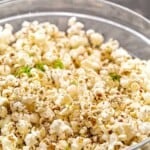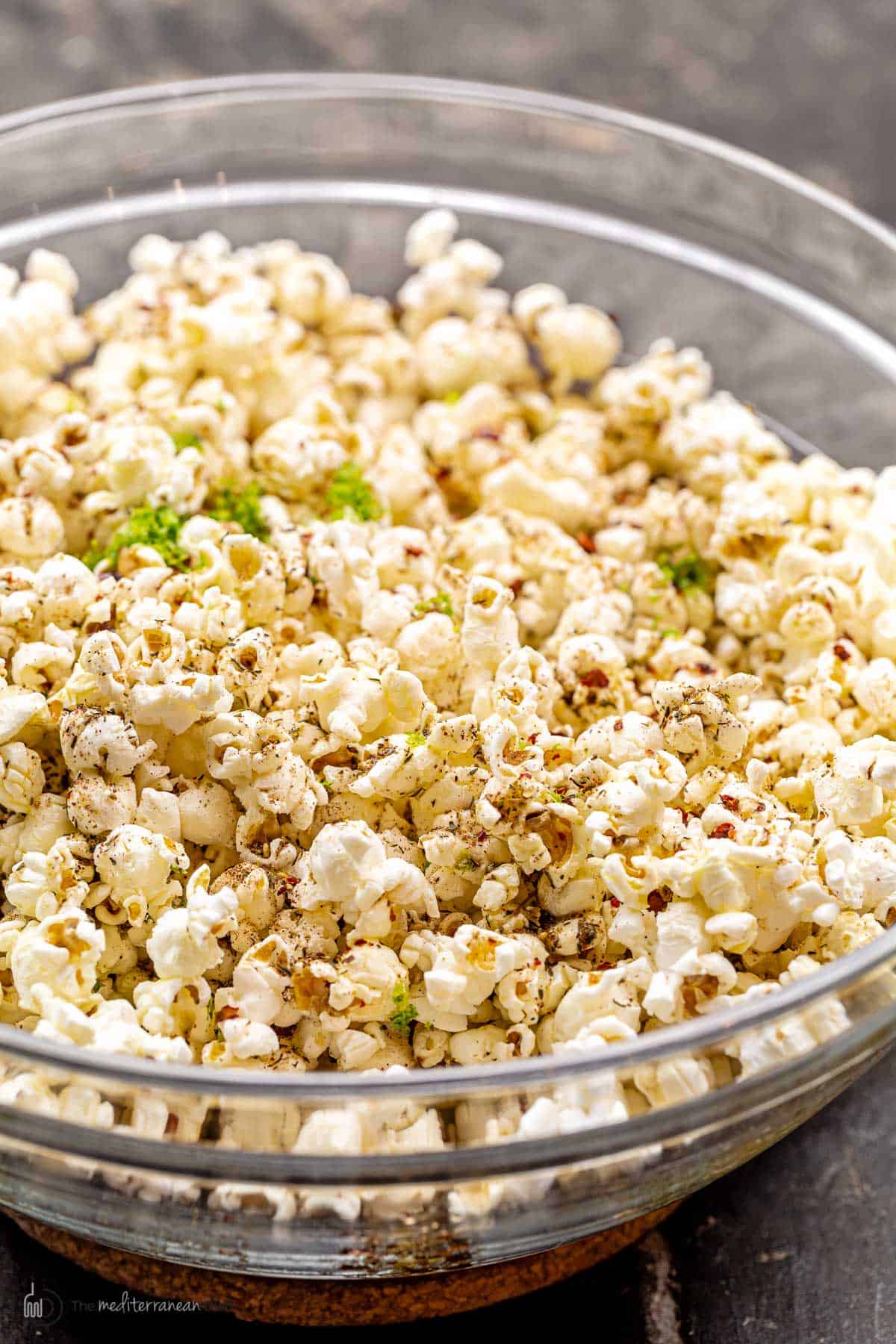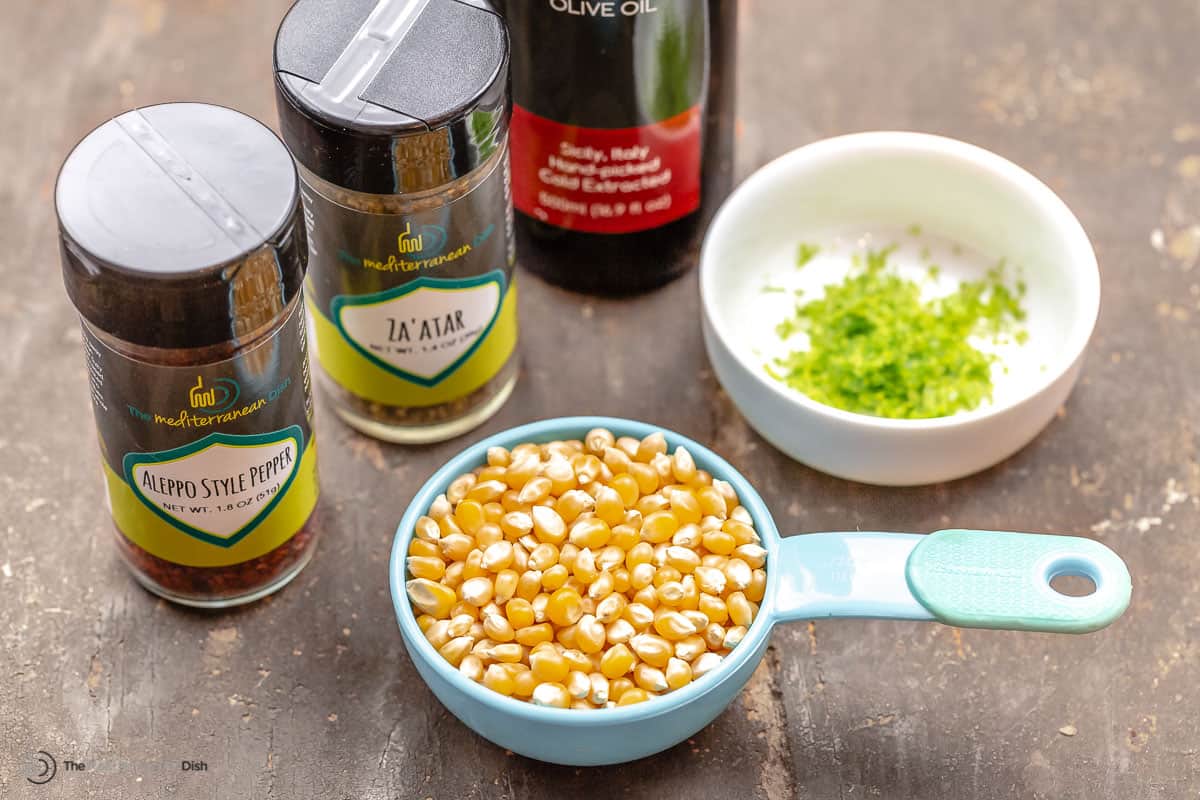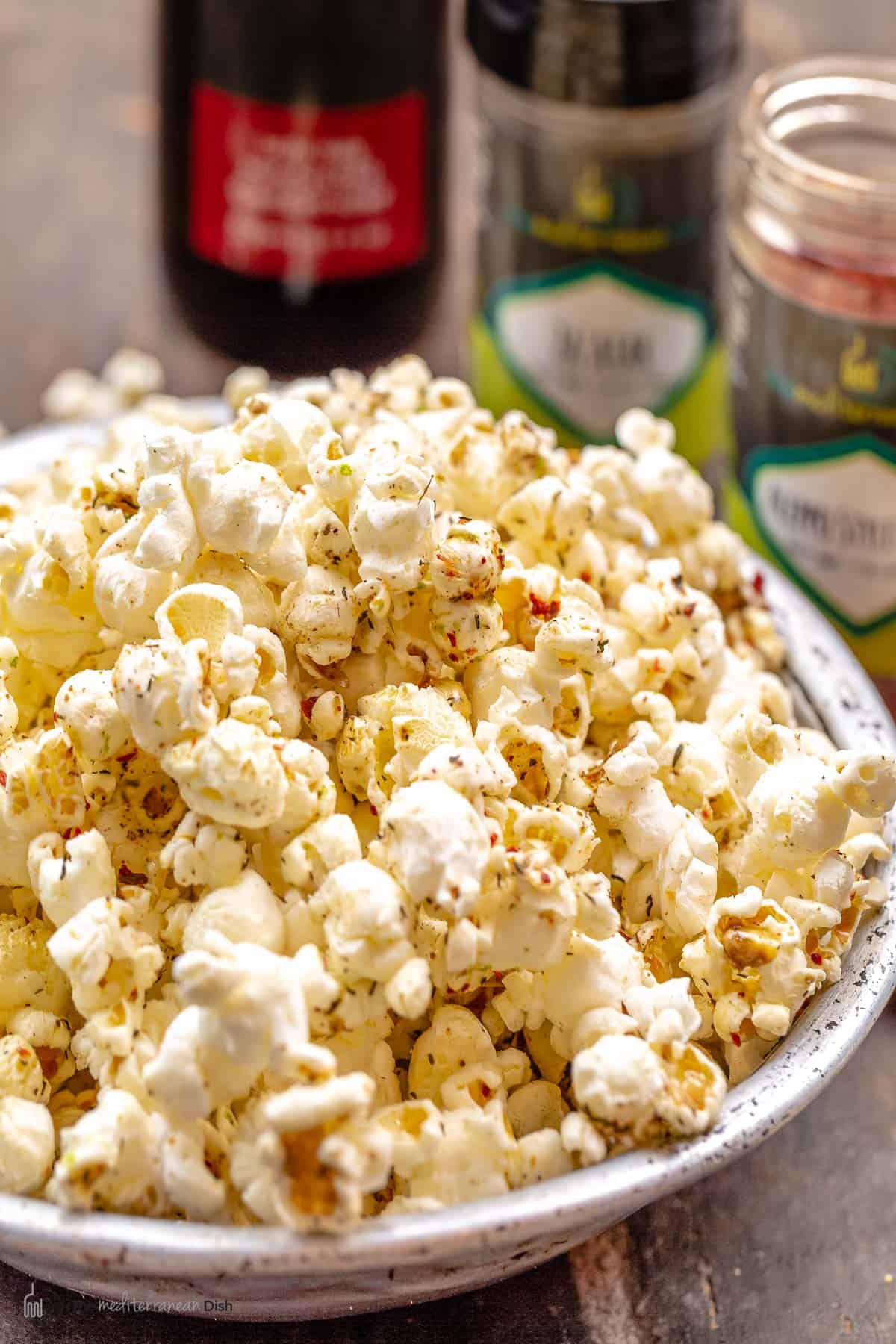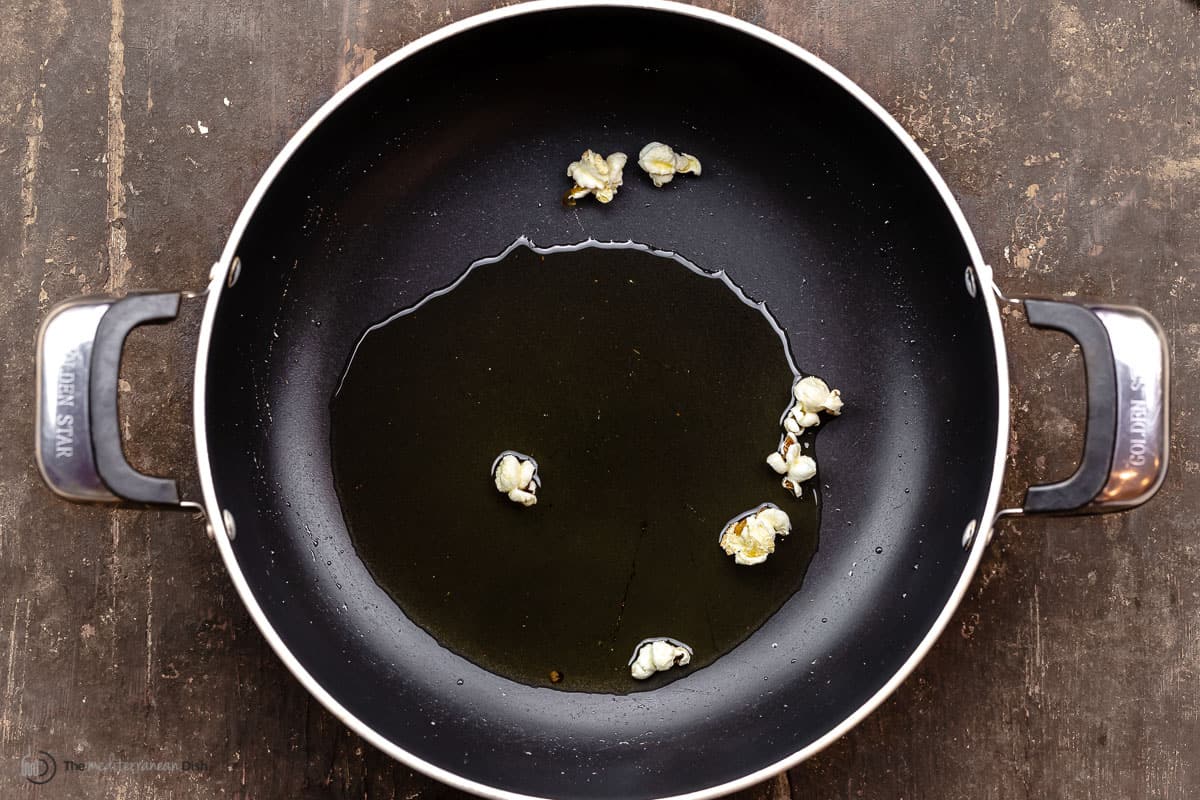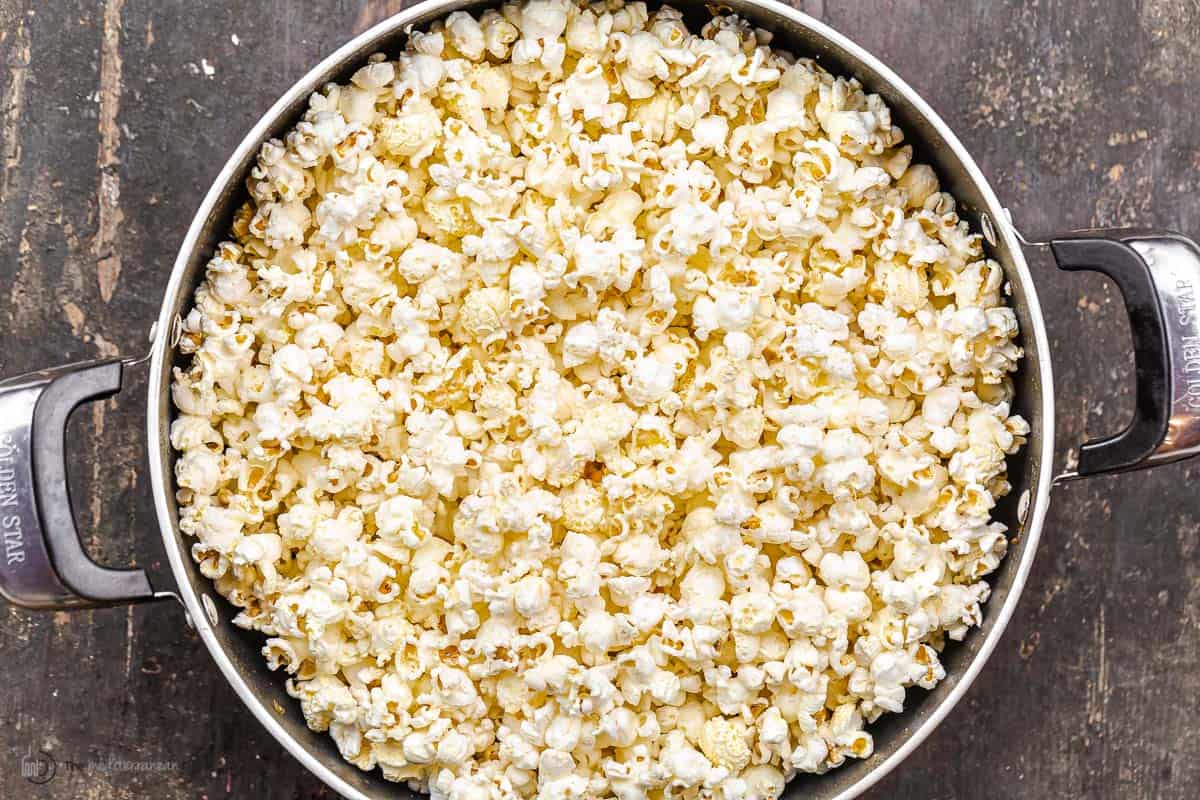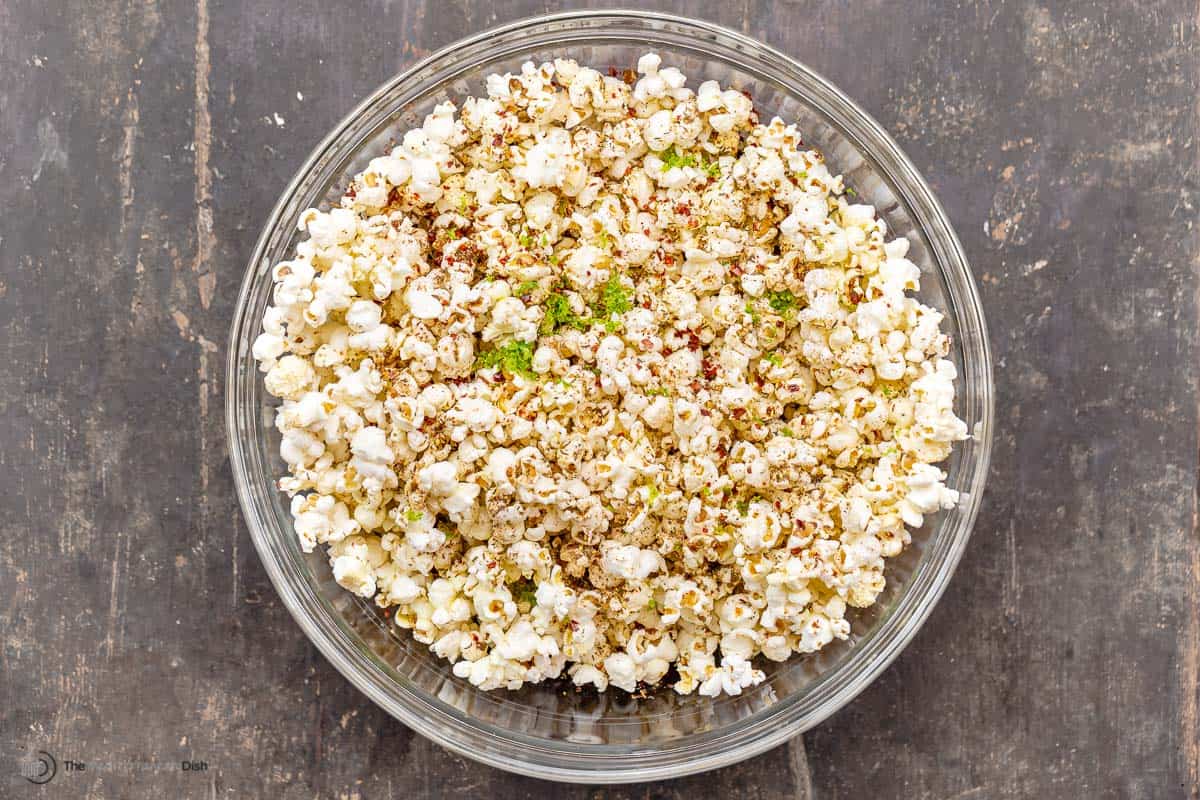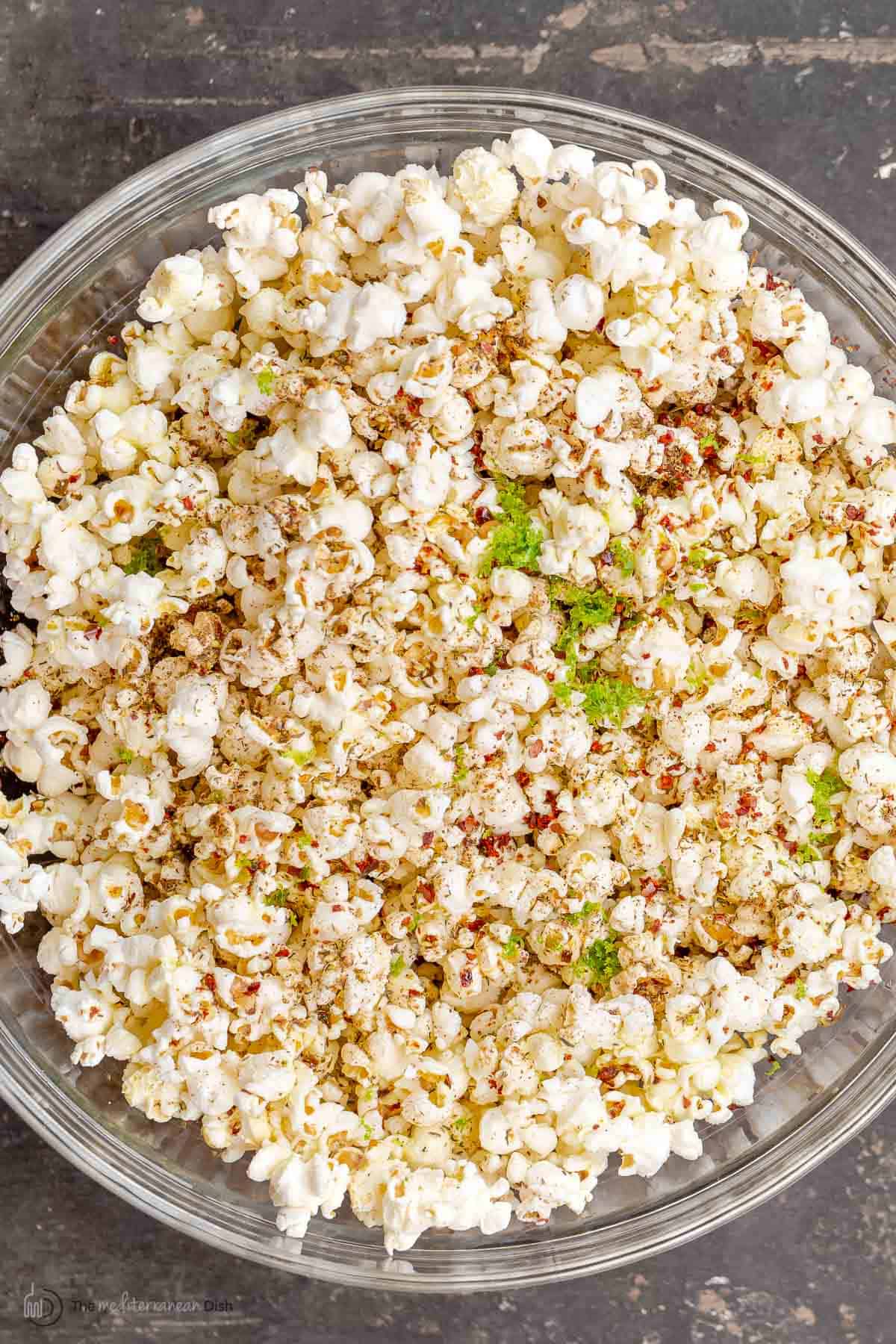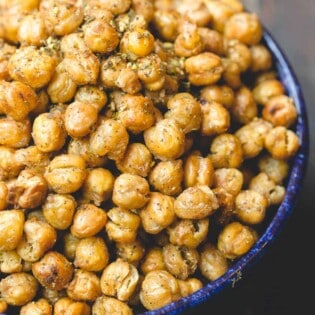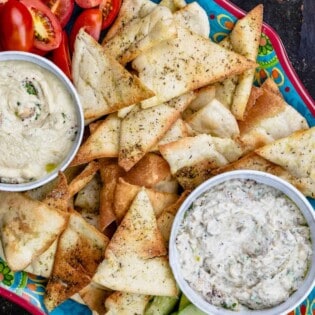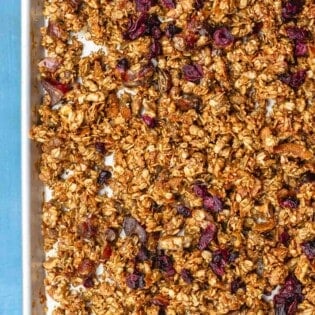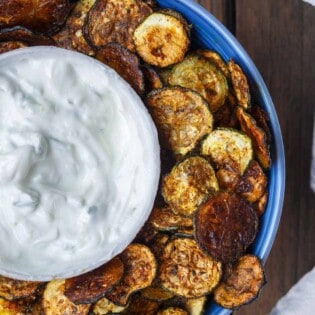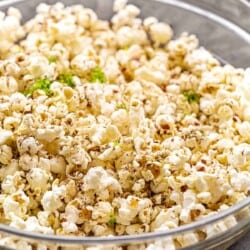Perfect stovetop popcorn
Once you learn how to make your own popcorn from scratch—so that every kernel is popped, and nothing is burned—you won’t be going back to the bagged stuff! The gist of this fiber-rich stovetop popcorn recipe is simple: Cook popcorn in a bit of extra virgin olive oil on the stove. Once it is done, immediately hit it up with a good drizzle of the EVOO, a generous sprinkle of kosher salt, and any number of seasonings you like (I have some options for you below). In today’s recipe, I used my favorite Mediterranean-style popcorn seasoning: za’atar, Aleppo pepper, and grated lime zest. I know, this sounds different, but trust me, you’ll love the bold, tangy, and slightly spicy combo. It goes very well with anything toasty and roasty, like this popcorn or even roasted pumpkin seeds. It is addictive!
Ingredients: What you’ll need for homemade popcorn
Making popcorn from scratch requires very few ingredients: Popcorn kernels, oil, and popcorn seasoning. No big deal, right? Let’s quickly walk through the ingredients with a few tips that you might find helpful.
Popcorn kernels
For this recipe, you’ll need ½ cup of popcorn kernels, which yields plenty of popcorn for a little crowd (anywhere from 10 to 14 cups). Did you know that there are several varieties of popcorn? Yellow kernels are the most commonly used and tend to be more crisp than other types of popcorn. White kernels are more difficult to find, but they tend to yield popcorn that is fluffier and more tender than yellow kernels. The fresher the kernels, the better your popcorn. So it’s important to store the kernels in an airtight container in a cool, dry room (such as an unheated pantry) to help them retain their freshness. Do not store kernels in the fridge or freezer, as this will compromise their ability to pop. Properly stored kernels can remain fresh for a long time (even years), but I try to cook mine within six months to a year for optimal fluffiness.
Best oil for popcorn
My favorite oil for tasty, perfectly crisp popcorn is extra virgin olive oil. It adds great flavor and richness, especially if you choose a fruity variety. More common oil choices for cooking stovetop popcorn are refined coconut oil and canola oil. Movie theaters usually use canola to make their popcorn. I personally prefer using olive oil, and the cooking time is very quick. (By the way, you may find this olive oil guide helpful).
Popcorn seasoning
Now this is the fun part! Once you perfect making popcorn from scratch, the possibilities for seasoning are endless. You can keep it simple with just a drizzle of good olive oil (or melted butter, if that’s what you like) and a good dash of kosher salt. Or, you can play up the flavors depending on your mood. Here are three seasoning options to try on your. homemade popcorn:
For tangy, spicy popcorn (with a Middle Eastern twist), try what I used in today’s recipe: olive oil, kosher salt, za’atar, Aleppo pepper, and lime zest. Za’atar is herby, tangy and nutty, complemented perfectly by bright lime zest. And piquant Aleppo pepper, with its distinctly sweet, sharp, slightly spicy taste, adds just a bit of a kick. For savory popcorn: Olive oil, kosher salt, and nutritional yeast. Nutritional yeast is the perfect seasoning if you want cheesy flavor but also want vegan popcorn seasoning. For sweet popcorn: Olive oil, cinnamon, and a dash of brown sugar. This will satisfy your sweet cravings without making your teeth hurt!
How to get seasoning to stick to popcorn?
No matter what seasoning you choose for your popcorn, the important thing is to get the seasoning to stick! That’s where the flavor is. One common issue people have when making homemade popcorn is that the seasoning sinks to the bottom of the bowl. A few tips to ensure well-seasoned popcorn:
Season while the popcorn is still hot! Don’t let the popcorn cool, as soon as it is ready, dump it in a large bowl and season right away. Add fat (adhesive liquid) first. You need a good drizzle of extra virgin olive oil (or melted butter) to help the seasoning to adhere to the popcorn. Using the oil while the popcorn is fresh off the stove helps prevent it from becoming soggy. Be sure to toss around so that the oil will coat the kernels well. Use dry seasoning. The wrong seasoning can be an issue as well. I typically use dry seasonings rather than fresh herbs. And if I want some tang, then I use lime zest but never lime juice.
How to make popcorn on the stove
Here’s how to make this easy homemade popcorn on the stovetop (printer-friendly recipe below):
Heat the oil. In a large saucepan or Dutch oven, add 3 to 4 tablespoons extra virgin olive oil and a few unpopped kernels (3 or so). Heat the oil until shimmering over medium-high heat. As soon as the kernels pop, remove them from the pan. Cook the popcorn on the stovetop. Add ½ cup popcorn kernels and cover the saucepan. It is helpful to use a large pot with a glass lid so you can see what’s going on inside. Give the saucepan a shake to ensure that the kernels are in a single layer. (This will help reduce the number of unpopped kernels at the end.) Lower the heat to medium. Once you hear popping sounds, you know the popcorn is cooking. Gently shake the pan from side to side a few times to prevent burning. When the popping slows down to one pop every few seconds, the popcorn is done. Immediately remove it from the heat. Season the homemade popcorn. Transfer the popcorn to a large bowl and immediately drizzle with a bit of EVOO. Season generously with a good dash of kosher salt and seasoning of your choice. (I used za’atar, Aleppo pepper, and fresh lime zest.) Toss gently with a large spoon or clean hands to coat. Taste and adjust seasoning if necessary.
Note: Do not leave hot oil unattended. The entire popcorn-cooking process takes just a few minutes, and it does require you to be at the stove watching it.
Tips for the best stovetop popcorn
Use a heavy-bottomed pan or Dutch oven. These distribute heat better and will lessen the chances of your popcorn cooking unevenly (meaning, some not popped at all and some totally burnt). Make sure the oil is heated properly. To check if your oil is hot enough, throw 2 or 3 kernels into the pan. Once they pop, you’ll know your oil is the right temperature. Remove the few popped kernels so they don’t burn and add the rest of the kernels to the pan. Shake the pan while the popcorn is cooking to prevent kernels from burning. As the corn kernels begin to pop, shake the pot a few times to keep the kernels moving. Season immediately. As soon as the popcorn is finished, transfer to a large bowl and immediately drizzle extra virgin olive oil on it while the popcorn is still hot, and then follow with a big dash of salt and seasoning. The oil will lightly coat the popcorn and give the seasonings something to cling to.
How to keep popcorn from getting soggy?
Homemade popcorn can become soft and wet because of all the steam that accumulates in the closed pot. Luckily, there’s a simple solution to this! To keep your popcorn mouthwateringly crunchy, when the kernels begin to pop vigorously, crack the lid open slightly so there is a little room for the steam to escape (my lid has a small hole at the top for venting). I’ve seen recipes that keep it cracked the entire cooking time, but I worry about popcorn or hot oil shooting out. And once it’s finished popping, immediately dump the popcorn into a large bowl. Don’t leave it in the hot pot.
How to store popcorn leftovers
Because this stovetop popcorn recipe is so quick and easy, I like making just enough for my family to finish in one sitting. Here are some tips for storing leftover popcorn:
If your popcorn looks like too much to eat all at once when it’s cooked, don’t season all of it. Instead, only season the portion you can eat right away. Store unseasoned popcorn in an airtight container once it reaches room temperature. (If the popcorn is still warm when you store it, steam might accumulate, leading to stale popcorn – or even mold.) It will keep for around 4 days. An unexpected way to prolong cooked popcorn’s life is to freeze it! Yes, you read right! While unpopped kernels shouldn’t be frozen, popped popcorn does really well in the freezer. Store it in an airtight container or freezer-safe bag (with as much air pushed out as possible). For best texture, don’t freeze popcorn for longer than 3 months. (Note as well that hard popcorn toppings like chocolate or caramel will freeze, so if you used them, allow the popcorn to come to room temperature before enjoying it to avoid any possible tooth damage!)
More Mediterranean snack recipes
Browse all Mediterranean recipes Visit Our Shop
How to Make Crispy Roasted Chickpeas
Easy Homemade Pita Chips Recipe
Homemade Olive Oil Granola Recipe
Crispy Baked Zucchini Chips Recipe (Video)
